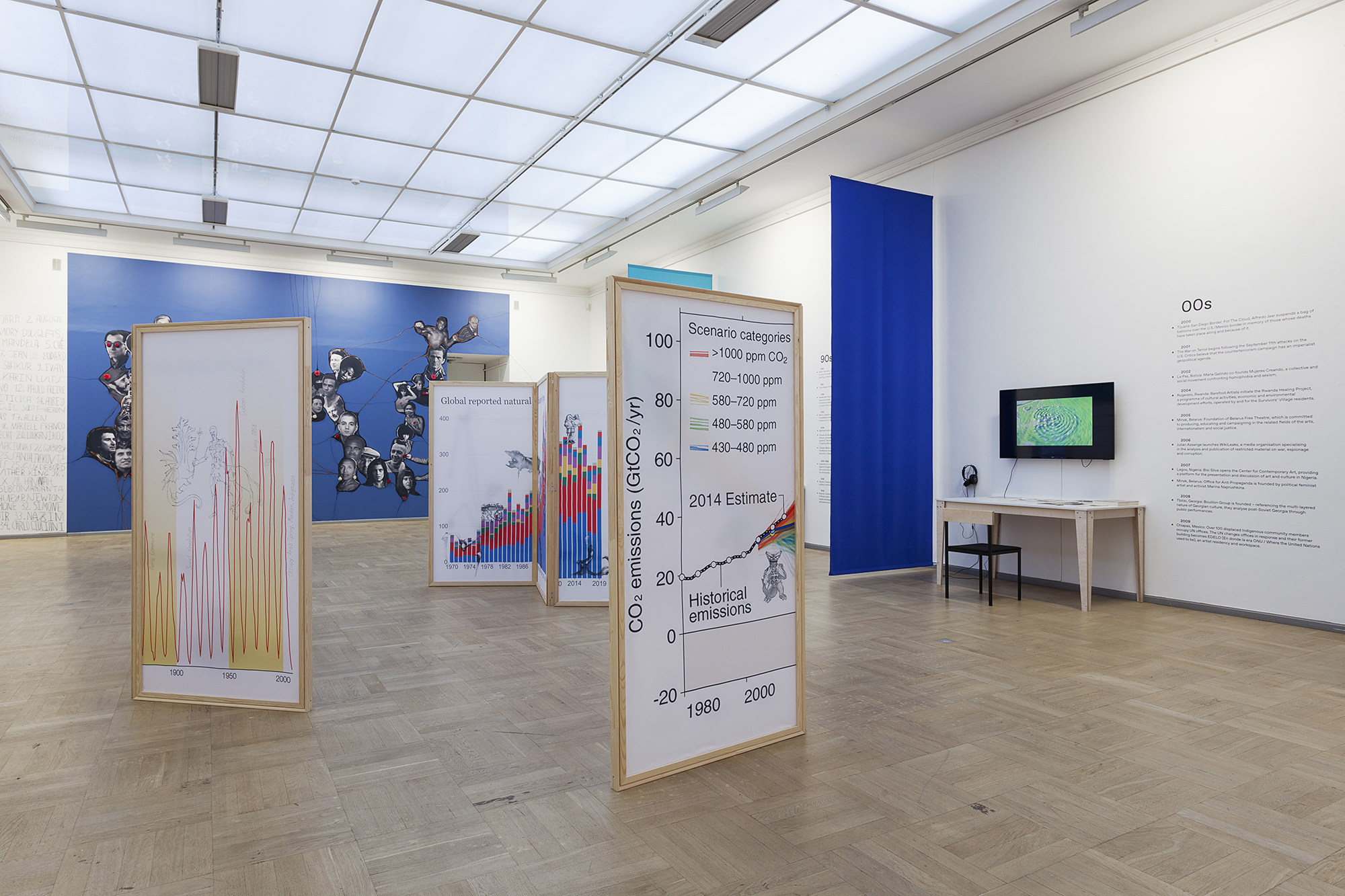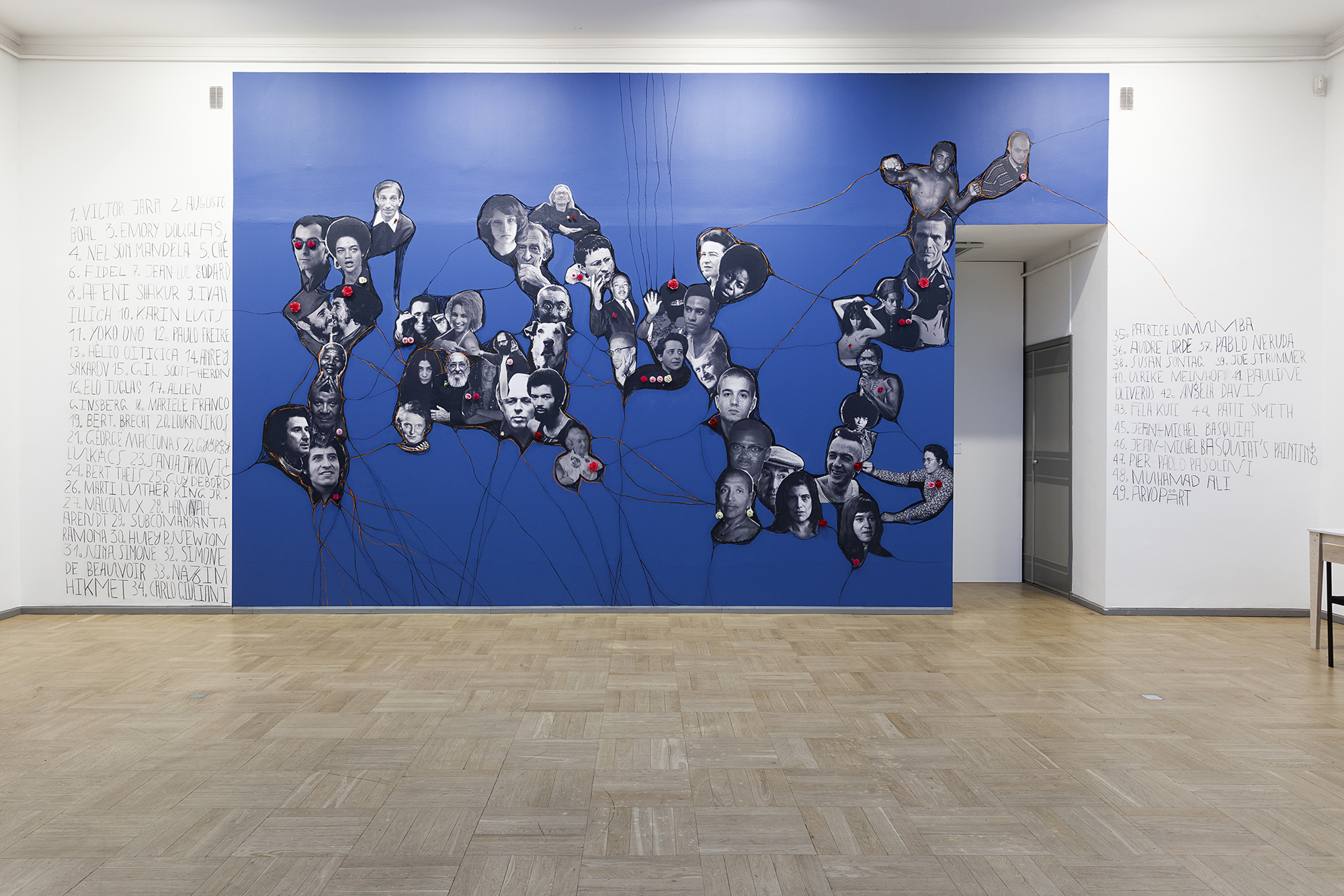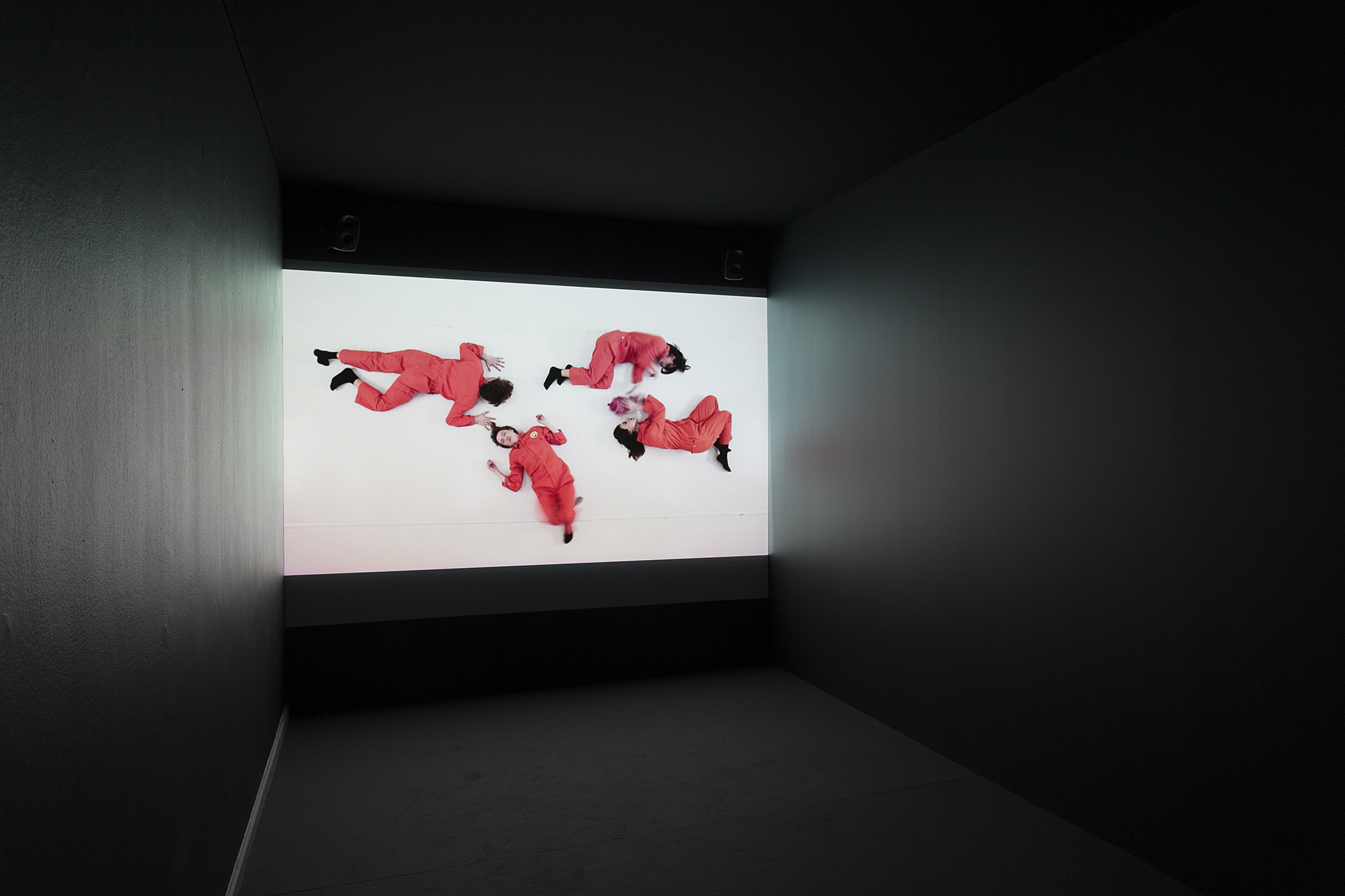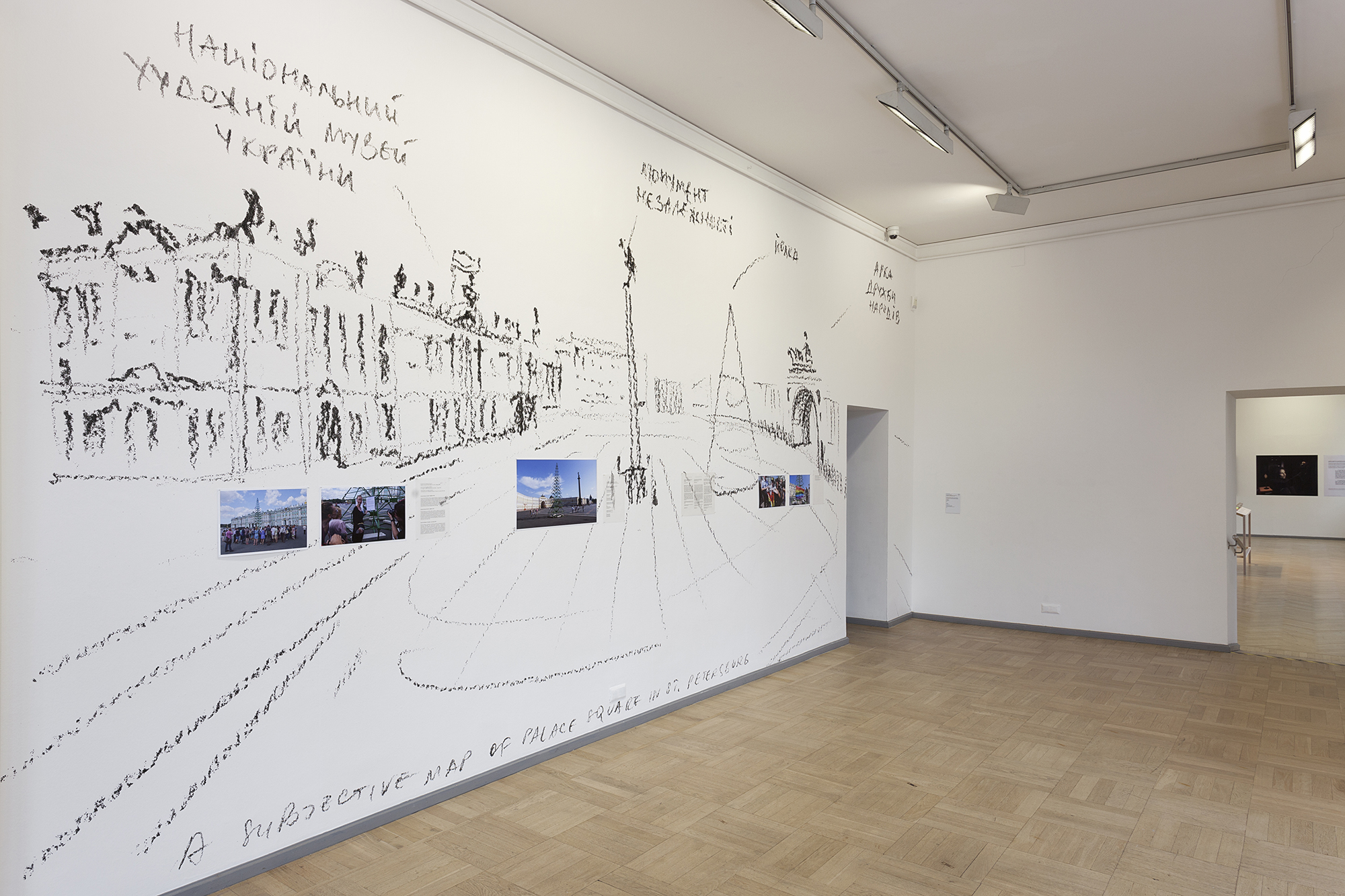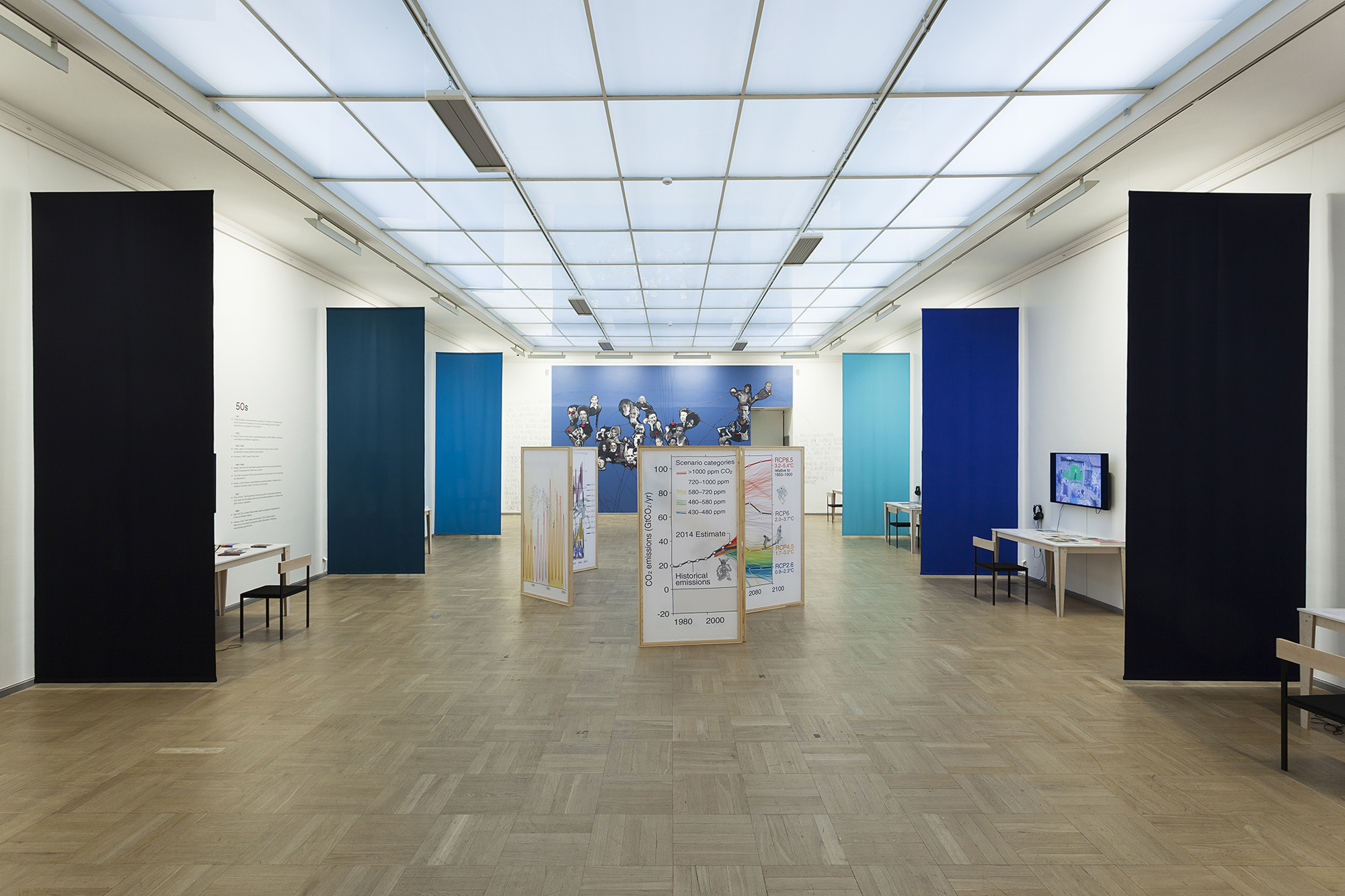What Makes Another World Possible?
Chto Delat?, On Art, Politics, and Engagement: A Timeline, 2021 [photo: Paul Kuimet; courtesy of Tallinn Art Hall, and Corina L. Apostol]
Share:
In 2019 Creative Time, in collaboration with Routledge, published a book edited by Nato Thompson and Corina L. Apostol that departed from 10 Creative Time Summits which took place between 2009 and 2017. Included were essays and projects centered on the practice of “socially engaged art,” which Apostol defined as “neither the reflection of reality nor the intervention into it, but rather the reality of this reflection that adds a new dimension into the struggle of changing it.”
In 2021 the ideas behind that publication were translated into an exhibition at Tallinn Art Hall, where Apostol is curator. The exhibition brought together works by artist contributors—among them Ala Younis, Dushko Petrovich, and Zach Blas—spanning existing works, adapted projects, and new commissions. Dan Perjovschi, for instance, drew all over the glass windows that look onto Freedom Square, where the kunsthalle was built in 1934; and where a Monument to the War of Independence (1918–1920) commemorates Estonia’s liberation from Russia. Some messages are written to be seen from inside the gallery, such as ‘THE FUTURE IS PRESENT,” others from the pavement below, including “FLOWER POWER.”
In her curatorial statement, Apostol describes the show as being organized “in the specific context of Estonia” in order “to raise fundamental questions” surrounding issues of socially engaged art within the region. With that in mind, an entire gallery has been given over to the irreverent Russian collective Chto Delat?, wherein the group worked with Apostol to install On Art, Politics, and Engagement: A Timeline (2021). Tables line the walls on opposite sides of the room. Books atop them and a screen overhead show documentation connected to a timeline for events organized by decade—from the 1940s, when wartime Estonia experienced Soviet and Nazi occupations, to the 2010s, when, in 2013, the Ukraine Euromaidan movement erupted. Historical moments mesh with developments in art history, from the 1981 establishment of the Women’s Action Forum in Karachi, to the 1984 emergence of political art collective Neue Slowenische Kunst in Yugoslavia, to the 1989 Tiananmen Square protests in Beijing, and the end of South African apartheid in 1994.
Chto Delat?, On Art, Politics, and Engagement: A Timeline, 2021 [photo: Paul Kuimet; courtesy of Tallinn Art Hall, and Corina L. Apostol]
These timelines led to a back wall, on which a collage of black-and-white portraits depicting historical figures created an alternative map of revolutionary world history against an azure-painted wall. Their names, listed in pencil on either side of the tableaux, refer to such figures as Jean-Luc Godard, George Maciunas, Yoko Ono, Fela Kuti, Nina Simone, Hannah Arendt, Audre Lorde, Malcom X, Paulo Freire, and Patrice Lumumba. At the gallery’s center, a series of charts tracked the evolution of Earth’s mean surface temperature from 1860 to 2020—a line whose consistent ascent seems exponential when viewed from 1920 to now.
Chto Delat?, On Art, Politics, and Engagement: A Timeline, 2021 [photo: Paul Kuimet; courtesy of Tallinn Art Hall, and Corina L. Apostol]
Behind the wall of names is a small screening room, in which an HD video by the collective was projected. One Night in a Social Network: An Opera Farce (2020) shows a man sitting at a table in a white room. He faces a manual screen on which his social media feed unfolds as an actual paper scroll, with emoji stickers arranged in front of him and poised for use, and a man under the table who sticks paper posts to this analogue timeline. The set-up recalls the 18th-century hoax of an automated chess-playing machine that was actually powered by a man hidden within the contraption. The device’s nickname, Mechanical Turk, has been lent to Amazon’s crowdsourcing platform, which connects businesses to remote workers who perform, per Wikipedia, “discrete [sic] on-demand tasks that computers are currently unable to do.”
Chto Delat?, One Night in a Social Network: An Opera Farce, 2020 [photo: Paul Kuimet; courtesy of Tallinn Art Hall, and Corina L. Apostol]
That figure under the table also doubles as a troll and courtly narrator. He sings, to the chords of his accordion, the story of his user’s internet feed: the killing of Russian journalist Arkady Babchenko, who fled to Ukraine in 2017, after his criticisms of Putin’s regime left him feeling unsafe. A chorus of four singers in orange prison jumpsuits, each representing an emoji, add to the intensifying emotional peaks and troughs that unfurl through wildly varied posts on the subject, and which alter the user’s responses in tandem. Finally Babchenko is revealed to be alive; his death was a hoax orchestrated by Ukrainian secret services in response to a suspected Russian plot against the journalist’s life. Through this emotional rollercoaster, Chto Delat? reveal a manufactured human drama whose tragedy is defined by its painfully obvious farce. Whether it’s journalists fact-checking Trump, or Boris Johnson’s open lies to the British parliament, or Putin’s public overtures toward a military invasion and veiled (and less veiled) threats against his political opponents, politicians know that we know that they know what we know. So here we are, in an era of post-truth. While digital screens are figuratively burning, the world literally burns.
As I write in February 2022, with tensions between Ukraine and Russia rising, this exhibition takes on an eerie resonance, thanks especially to Kristina Norman’s installation Interventions on Palace Square (2014), first shown in St. Petersburg for Manifesta 10 amid the Russian annexation of the Crimea in 2014. At Tallinn Art Hall, one gallery wall bore a roughly drawn image of Palace Square, in front of St. Petersburg’s Winter Palace, but annotated with names associated with locations around Independence Square in Kyiv. Photographs pasted over the drawing depicted Souvenir (2014), a metal Christmas tree based upon a symbol for the Euromaidan protests that the artist installed outside the Winter Palace—a provocation, effectively, that invited the people of St. Petersburg to remember the massacres and revolutions which took place at this very location, throughout Russian history, while reflecting on those that have occurred in Ukraine.
Kristina Norman, Interventions on Palace Square, 2014 [photo: Paul Kuimet; courtesy of Tallinn Art Hall, and Corina L. Apostol]
It is notable that, in the increasingly tense political atmosphere surrounding Manifesta 10 and the unfolding situation in the Crimea, the director of the Hermitage—the museum that hosted Manifesta 10—released a statement at the time that turned Souvenir into a warning against the chaos at Maidan. “Be aware!” he cautioned. “Disturbances can be born out of innocent entertainments.” This statement completely plays into Norman’s Manifesta 10 intervention, while similarly illustrating Apostol’s definition of socially engaged art. Nothing affirms art’s utility more than a state bureaucrat’s public declaration of its danger.
Chto Delat?, On Art, Politics, and Engagement: A Timeline, 2021 [photo: Paul Kuimet; courtesy of Tallinn Art Hall, and Corina L. Apostol]
Stephanie Bailey is editor in chief of Ocula magazine, a contributing editor at LEAP, and a regular contributor to Artforum International, Yishu: Journal of Contemporary Chinese Art, and dɪ’van: A Journal of Accounts. Formerly the senior editor of Ibraaz, where she worked 2012–2017, Bailey is also a member of the Naked Punch editorial committee; a managing editor of Podium, the online journal for M+ in Hong Kong; and the current curator of Art Basel Conversations in Hong Kong.
